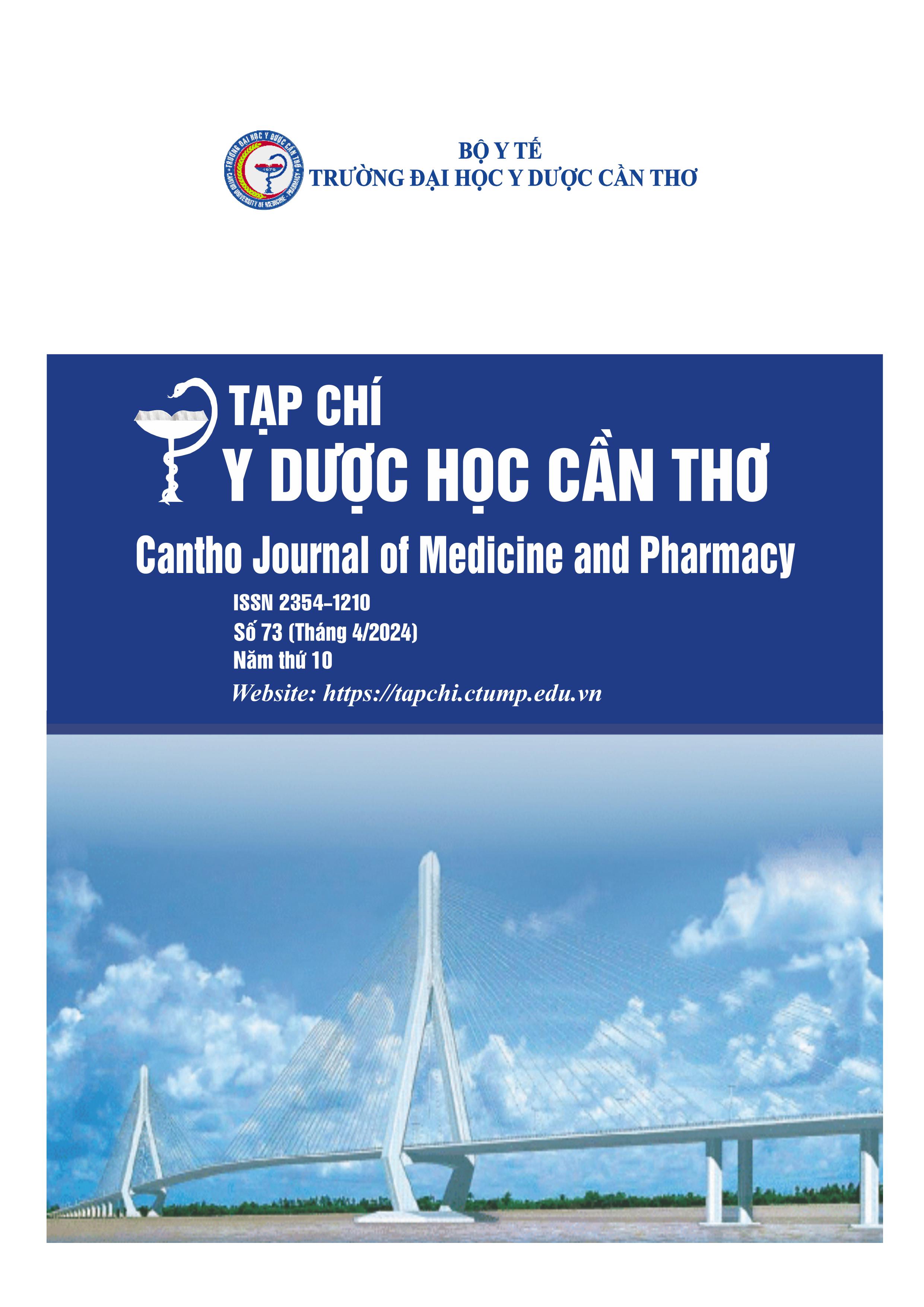THE SITUATION OF TOXOCARA CANIS LARVAE INFECTION AMONG PATIENTS WITH CHRONIC SPONTANEOUS URTICARIA
Main Article Content
Abstract
Background: Diseases caused by helminths, specifically Toxocara canis larvae (T. canis) is often found in people with chronic spontaneous urticaria (CSU), but the relationship of two factors is a controversial issue. Objectives: To determine the seroprevalence and revelant factors response to T. canis among CSU patients. Materials and methods: A cross – sectional study was conducted in 300 patients with CSU using serological diagnosis of T. canis larvae by enzyme – linked immunosorbent assay (ELISA). Results: The proportion of T. canis infection in the study subjects was 17.7%, concentrated mainly at the age of 37.4 ± 11.8 years old. T. canis (+) and (-) group had the mean duration of urticaria (12.6 ± 16.7 months, 14.8 ± 23.4 months) and urticaria activity score (4.60 ± 1.1 points, 4.4 ± 1.5 points) which were not significantly different (p > 0.05). The mean peripheral blood eosinophil counts in T. canis (+) group was not different with that in T. canis (-) group. The mean serum total IgE levels was significantly different between T. canis serological positive (468.6 ± 728.7 IU/mL) and negavive groups (248.1 ± 370.2 IU/mL) (p = 0.003). The factors of contacting with soil, eating raw vegetables, and food were related to T. canis infection (p < 0.05). Conclusion: The proportion of CSU patients seropositive for T. canis in the study was 17.7% (53/300). The mean serum total IgE levels was related to T. canis infection. In contrast, the mean duration of urticaria, urticaria activity score, peripheral blood eosinophil counts were not related to this parasitic infection.
Article Details
Keywords
Blood esionophil count, urticarial activity score, serum total IgE levels, duration of urticaria, Toxocara canis (T. canis)
References
2. Gavignet B, Piarroux R, Aubin F, Millon L, Humbert P. Cutaneous manifestation of human Toxocariasis. Am Acad Dermatol. 2008. 59, 1031-42, doi: 10.1016/j.jaad.2008.06.031.
3. Viñas M., Postigo I., Suñén E., Martínez J. Urticaria and silent parasitism by Ascaridoidea: Component-resolved diagnosis reinforces the significance of this association. PLoS neglected tropical diseases. 2020. 14(4), e0008177, doi: 10.1371/journal.pntd.0008177.
4. Nguyễn Thị Thanh Quân, Nguyễn Thị Hải Yến, Phạm Quốc Khánh. Nghiên cứu tình hình nhiễm và yếu tố liên quan đến nhiễm Toxocara canis, Strongyloides stercoralis, Echinococcus ở bệnh nhân nổi mày đay tại bệnh viện chuyên khoa tâm thần và da liễu tỉnh Hậu Giang năm 2019 - 2020. Tạp chí Y Dược học Cần Thơ. 2020.32. https://doi.org/10.58490/ctump.2022i55.408.
5. Zuberier Torsten, Aberer Werner, Asero Riccardo, et al. The international EAACI/GA2LEN/
6. EDF/WAO guideline for the definition, classification, diagnosis and management of urticarial. Allergy. 2022. 77, 734 – 766. doi: 10.1111/all.13397.
7. Thân Trọng Quang, Trần Vũ Hòa, Nguyễn Trần Uyên Phương. Tỉ lệ huyết thanh dương tính với ấu trùng Toxocara canis và một số yếu tố liên quan ở bệnh nhân đến khám tại bệnh viện Đại học Tây Nguyên, năm 2021. Tạp Chí Y học Việt Nam. 2022. 518(1), https://doi.org/10.51298/vmj.v518i1.3369
8. De Martinis M, Sirufo MM, Suppa M, Di Silvestre D, Ginaldi L. Sex and Gender Aspects for Patient Stratification in Allergy Prevention and Treatment. International Journal of Molecular Sciences. 2020. 21(4), 1535, doi: 10.3390/ijms21041535.
9. Jonathan A. Bernstein, Laurence Bouillet, Teresa Caballero, Maria Staevska, Hormonal Effects on Urticaria and Angioedema Conditions. The Journal of Allergy and Clinical Immunology: In Practice. 2021, 9 (6), https://doi.org/10.1016/j.jaip.2021.04.021.
10. Phan Thị Nhã Trúc, Huỳnh Hồng Quang, Phan Văn Trọng, Lê Đình Vĩnh Phúc. Đặc điểm lâm sàng và cận lâm sàng trong chẩn đoán bệnh giun đũa chó/mèo ở người. Tạp chí phòng chống bệnh sốt rét và các bệnh ký sinh trùng. 2020. 3 (117).
11. Lê Đình Vĩnh Phúc. Nghiên cứu đặc điểm lâm sàng, cận lâm sàng và kết quả điều trị bằng thiabendazole trên người mắc bệnh ấu trùng giun đũa chó, mèo tại trung tâm Medic Thành phố Hồ Chí Minh (2017 – 2019). Luận án Tiến sĩ, Viện sốt rét – Ký sinh trùng – Côn trùng Trung ương. 2021. 144.
12. Huỳnh Hồng Quang, Phan Thị Nhã Trúc, Lê Đình Vĩnh Phúc, Phan Văn Trọng. Đặc tính nhiễm, kiến thức, thái độ và thực hành về phòng chống bệnh ấu trùng giun đũa chó/mèo trên bệnh nhân đến khám tại bệnh viện Đa khoa Thiện Hạnh tỉnh Đắk Lắk. Tạp chí phòng chống bệnh sốt rét và các bệnh ký sinh trùng. 2020. 1 (115).
13. Nguyễn Tấn Vinh, Đặng Văn Chính và Lê Thị Ngọc Ánh. Tỷ lệ nhiễm giun đũa chó, mèo trên trẻ em tại xã Thạnh An, huyện Vĩnh Thạnh, thành phố Cần Thơ. Tạp chí Y học thành phố Hồ Chí Minh. 2019. (5), 561-70.
14. Vũ Thị Thu Băng, Nguyễn Ngọc San, Trần Huy Thọ. Một số đặc điểm lâm sàng, cận lâm sàng ở bệnh nhân nhiễm ấu trùng giun đũa chó/mèo Toxocara spp. đến khám tại bệnh viện Đặng Văn Ngữ năm 2021 - 2022. Tạp chí phòng chống bệnh sốt rét và các bệnh ký sinh trùng. 2022. 2 (128).
15. Stear M, Preston S, Piedrafita D, Donskow-Łysoniewska K. The Immune Response to Nematode Infection. International Journal of Molecular Sciences. 2023. 23, 24(3), 2283, doi:
10.3390/ijms24032283.


